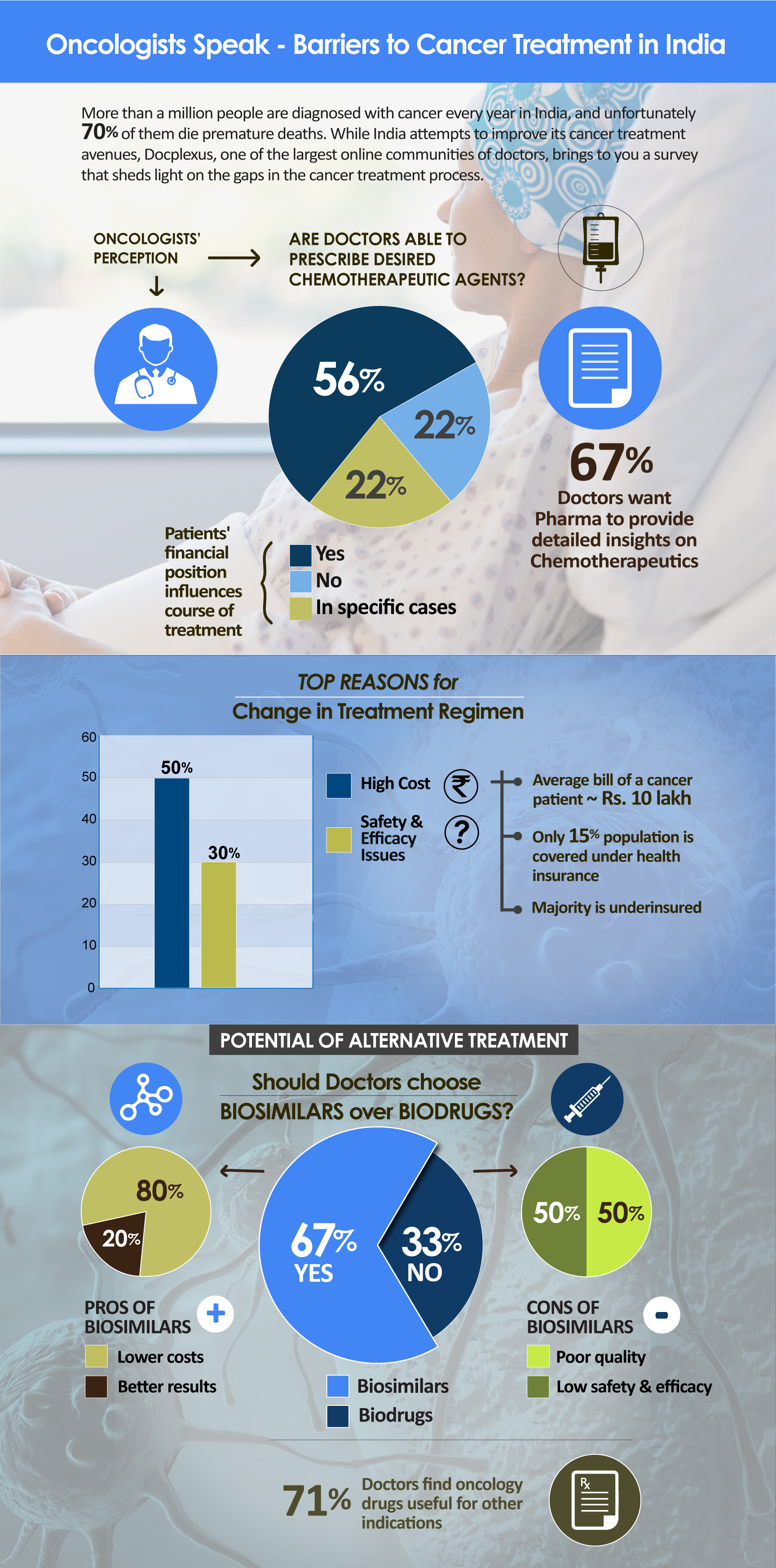
The latest report from National Programme for Prevention and Control of Cancer, Diabetes, Cardiovascular and Stroke (NPCDCS) stated that cancer incidence has risen 36% from 2016 to 2017, a million new cases reported every year, two-thirds of which succumb. The NPCDCS report also found that cancer is one of the leading causes of premature deaths in India. According to a report by the BRICS nations, this loss amounts to 0.33% of India’s total GDP every year.
Access to affordable and effective treatment is crucial to lower morbidity and mortality associated with cancer. Docplexus, India’s largest online community of doctors, conducted a survey to understand doctors’ views on hurdles to better management and treatment of cancer.
Survey Details:
Aim – To understand doctors’ perception on improving management and treatment of cancer
Survey Methodology – A nation-wide poll on Docplexus members
Sample Size – Survey was completed by 263 oncologists

Major findings of the survey:
• 22% doctors unable to prescribe preferred chemotherapeutics, high costs concern 50%
Cost of chemotherapeutic drugs is quite high in India, and a large section of the patients are unable to afford these. The average treatment duration for cancer is between three and six months and huge costs incurred on multiple cycles of chemotherapy add further financial burden on patients.
Age of the patient also determines drugs to be prescribed for treatment. Dr. Harbans Kapoor, a cancer consultant and the former director of Indira Gandhi Medical College, Mandi, Himachal Pradesh, said, “We look at the cost to benefit ratio. If the patients are young, then we would insist on taking the best suitable drug, despite the cost. But, if the patient is old, say above 80, we would consider the cost factor as the results will not be effective.”
The country’s insurance landscape is not rosy to cover such expenses. Only about 15 percent of the country’s population is insured and a large chunk of that is under-insured. While average policy amount in 2011 was about Rs 1.9 lakh, average bill footed by a cancer patient was nearly Rs10 lakh. Besides, stage at which cancer detected also has an impact on preferred treatment. For instance, if a patient is detected at an early stage, a simple surgery holds potential to work. At an advanced stage, doctors prefer targeted drugs but face pressure due to costs. 50% oncologists therefore stated they are forced to change treatment regimen. Alternatives such as radiation therapy and biosimilars are then considered.
The recent shakeup in Chinese factories due environmental concerns adds to pricing woes of domestic drug industry, with fears of supply disruptions and inflationary pressures at an all-time high. It is observed that some of the largest hikes are those in oncology’s key starting material, like 5-Fluorocytosine and HMDS (60% and 484% increase respectively).
• Safety and efficacy issues with chemotherapeutic agents
Nearly 30% physicians mentioned lack of evidence on safety and efficacy of chemotherapeutic agents as a hurdle. About 67% doctors said they seek detailed insights on chemotherapeutic agents from Pharma as it helps choose the best treatment option.
In the digital era, doctors seek information online about the latest updates in oncology, the new treatment avenues, information about new and even existing drugs. 42% respondents said they get latest oncology updates from Docplexus, 25% said they engage in meaningful peer-to-peer discussion on the platform and about 17% conveyed that they are receiving significant insights from thought leaders about better medical practices.
• Biosimilars are an alternative to chemotherapeutic drugs, but safety, efficacy and quality are a concern
A good 67% doctors were convinced that biosimilars are best-suited alternatives for expensive chemotherapeutic agents. Some even stated biosimilars demonstrate better results as compared to biodrugs. 33% doctors, however, conveyed that they would not prescribe biosimilars as alternative chemotherapeutic drugs. Half of them raised concerns about safety and efficacy, while the rest questioned quality.
On this, Dr. Kapoor stated, “I would prefer prescribing a biosimilar over a chemotherapeutic drug if it is a proven product. The quality control of biosimilars in India is a concern.”
It is an opportunity for Pharma to think of ways for allaying fears and incorporate them into their marketing communications.
• Oncology drugs have huge potential for other indications
It is often found that a drug designed for treating a particular disease shows positive outcomes for others. Asked if they would prescribe oncology drug for other indications, nearly 70% oncologists answered in affirmative. For instance, doctors stated that oncology drugs may work well for rheumatoid arthritis or eye diseases. Results can range from healing to simply improving well-being. Besides, one cancer drug itself may be effective for treating multiple types of cancer. In cases where cancer is causing pain or irritation in some part of the body, one or the other such drug might prove highly beneficial.
Key Takeaways for Pharma:
1. Better affordability of chemotherapeutics could drive prescription rates
2. Biosimilars are favored when presented with evidence on safety, efficacy and quality.
3. Oncology drugs have potential to cure other diseases.
4. Digital media is a preferred source of medical information for oncologists
Docplexus is one of the world’s largest & fastest-growing networks of verified doctors & a trusted marketing partner of pharma, medical devices, diagnostics & nutraceutical companies. We empower our industry partners to meaningfully engage with the medical community through data-driven, evidence-based marketing & brand management solutions such as infocenter (branded microsite), mindset analysis, KOL webinars, sponsored medical updates, online CMEs & more.
